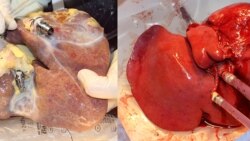Swiss researchers have developed a machine that, they say, can keep human livers alive outside of the body for one week.
Current technology and methods are only able to keep human livers alive for up to 24 hours.
The new machine is able to keep the liver active by performing several functions normally carried out by the human body.
Researchers say they expect the technology to greatly increase the number of livers available for transplant. This could save the lives of many patients suffering from severe liver disease who need to have their liver replaced.
Scientists from the University of Zurich in Switzerland developed the machine. They recently reported their results in the publication Nature Biotechnology.
The researchers say the purpose of their “Liver4Life” machine is to perform what they call liver perfusion operations outside of the human body. Perfusion is the process by which blood or other fluids are pumped through organs and tissue.
The machine keeps the liver at the right temperature and moves it in a way that would be natural in the body. It uses a pump to fill the liver with blood acting like a replacement for a human heart. The machine also provides oxygen to the organ, controls red blood cell levels and removes waste.
A healthy liver is necessary to support life. The liver receives about 25 percent of blood from the heart and carries out about 5,000 different tasks in the body.
Livers are among the most commonly transplanted human organs. Most transplants involve patients suffering from severe liver disease or cancer.
The Mayo Clinic in the state of Minnesota reported that, in 2017, about 8,000 liver transplants were performed in the U.S. among adults and children. Of those, 360 involved livers from living donors. In addition, about 11,500 people were registered on a waiting list to receive a liver transplant, the organization said.
Keeping livers alive and functioning for longer periods could greatly improve the chances of survival for patients.
The research team began their experiments using livers from pigs. After repeated testing and engineering development, the team said it was able to get the pig livers to survive for seven days with support only provided from the Liver4Life machine.
The scientists said they also discovered that the system can work to repair damaged livers. In one test, the team connected the machine to 10 injured human livers that had been rejected for transplantation by all European medical centers.
After seven days of perfusion treatment from the machine, six of the human livers fully regained important liver functions, the researchers reported.
Pierre-Alain Clavien is chairman of the Department of Surgery and Transplantation at University Hospital Zurich. He helped lead the research.
“The success of this unique perfusion system - developed over a four-year period by a group of surgeons, biologists and engineers - paves the way for many new applications in transplantation and cancer medicine, helping patients with no liver grafts available,” Clavien said in a statement.
He added that the successful treatment of poor-quality livers could lead to a wide range of new treatment possibilities. Such treatments could be used to repair preexisting liver damage, remove fat from the organ or even recreate partial livers.
The team is now planning its next step in the development process. It is making preparations to transplant machine-treated organs into patients.
I’m Bryan Lynn.
Bryan Lynn wrote this story for VOA Learning English, based on reports from the University of Zurich and Nature Biotechnology. Mario Ritter, Jr. was the editor.
We want to hear from you. Write to us in the Comments section, and visit our Facebook page.
________________________________________________________________
Words in This Story
function – n. the purpose of something
transplant – n. an operation in which an organ or tissue is transplanted
unique – adj. different from everything else
pave the way - idiom to make it easier for something to happen
graft – n. piece of healthy skin or bone cut from a person’s own body and used to repair a damaged part on that person
range – n. group of different things of the same general type












